Standing on the Continental Divide, where wind energy could reshape the West
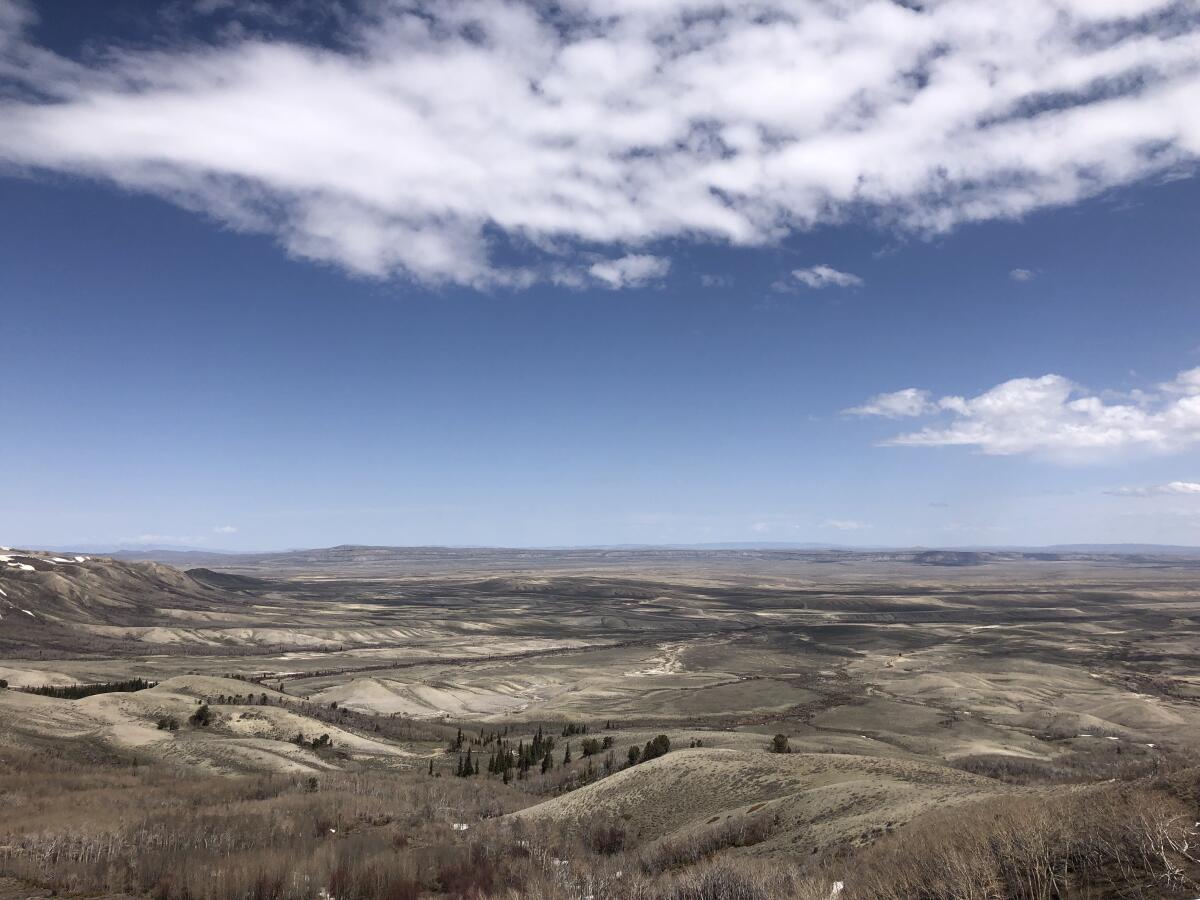
- Share via
This is the May 5, 2022, edition of Boiling Point, a weekly newsletter about climate change and the environment in California and the American West. Sign up here to get it in your inbox.
Reporting on clean energy from my kitchen table is one thing. Standing atop the Continental Divide — wind whipping at my face, construction workers grading roads nearby, pronghorn jogging across the sagebrush landscape — is something else entirely.
I’m writing to you from Highway 789, a lonely two-lane road that runs south through Wyoming’s Carbon County toward the Colorado state line. L.A. Times photographer Rob Gauthier is in the driver’s seat, gamely navigating us through sporadic rain and the occasional bump in the road. I can see our three-person video team following not far behind in the side-view mirror.
As I previewed last week, we’re taking a road trip across the American West to explore the transition to clean energy. After flying to Denver, we journeyed north into Wyoming and toured a sprawling cattle ranch — at 500 square miles, it’s slightly larger than L.A. — where Phil Anschutz, who owes his $11-billion fortune in part to oil and gas, is preparing to build the nation’s largest wind farm.
Now we’re traveling the route of the 732-mile power line Anschutz plans to build through Wyoming, Colorado, Utah and Nevada, to send all that clean energy to California. The electric wires would run roughly parallel to Highway 789, several miles to our west.
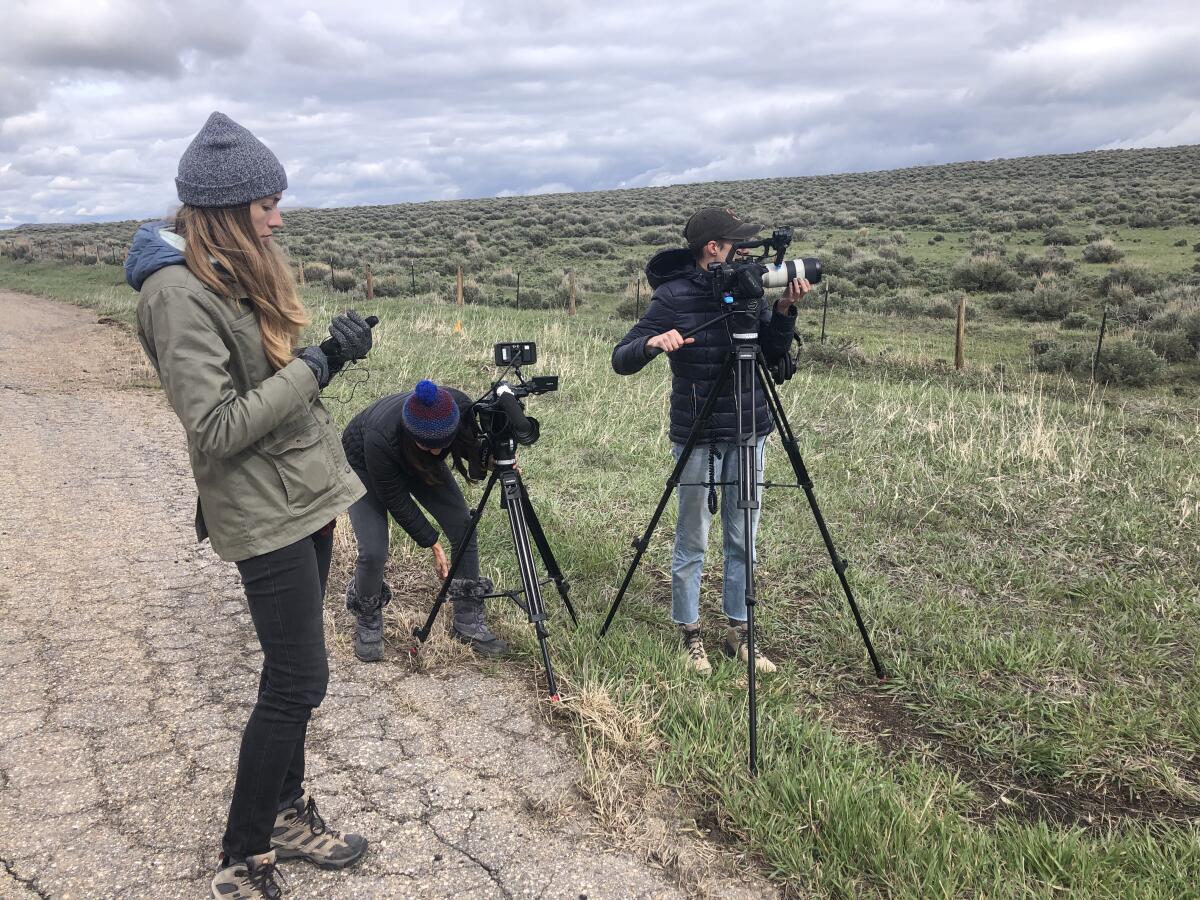
It’s been a fascinating few days, and I’ll have a full story soon. Until then, here are some highlights from the road.
Our first stop heading out of Denver — after Starbucks — was Medicine Bow, Wyo., founded in 1868 as a watering station along the nearly finished transcontinental railroad. The tiny town is best known today as the setting for “The Virginian,” considered the first Western novel. We stopped at the Virginian Hotel, opened in 1911, where the dining room is named for Owen Wister, the author of the 1902 novel and a friend of Teddy Roosevelt. Per a recommendation, I tried the hotel’s homemade cherry pie. It was good.

I’ve actually been carrying a copy of “The Virginian” in my backpack. I haven’t read too far yet, but I did enjoy how Wister’s narrator described small Western towns in the book’s second chapter. It’s a damning indictment and poignant praise all at once:
“Scattered wide, they littered the frontier from the Columbia to the Rio Grande, from the Missouri to the Sierras. They lay stark, dotted over a planet of treeless dust, like soiled packs of cards. Each was similar to the next, as one old five-spot of clubs resembles another. Houses, empty bottles, and garbage, they were forever of the same shapeless pattern. More forlorn they were than stale bones. They seemed to have been strewn there by the wind and to be waiting till wind should come again and blow them away.
“Yet serene above their foulness swam a pure and quiet light, such as the East never sees; they might be bathing in the air of creation’s first morning. Beneath sun and stars their days and nights were immaculate and wonderful,” Wister wrote.

After leaving Medicine Bow, we visited a wind farm operated by PacifiCorp, a six-state power company owned by Warren Buffett. Known as Ekola Flats, it’s surrounded by several other wind farms — we could see hundreds of turbines spinning in the nearby hills and dotting distant mountain ridges. They supply PacifiCorp customers from Salt Lake City to Northern California.
What amazed me most was the sheer size of the turbine we stood under while talking with PacifiCorp executives. At 262 feet high, the tower holding up the blades wasn’t unusual. But the blades — my God, it seemed like they were going to hit us every time they swooped down toward the ground. Each blade was 219 feet long, part of a wind energy machine with a capacity of 4.3 megawatts — almost six times as much power as some of the old steel-lattice wind towers still generating electricity outside Palm Springs.
Laine Anderson, PacifiCorp’s director of wind operations, told me the company doubled its wind energy footprint in 2020.
“The technology is very sophisticated,” he said, in an understatement.
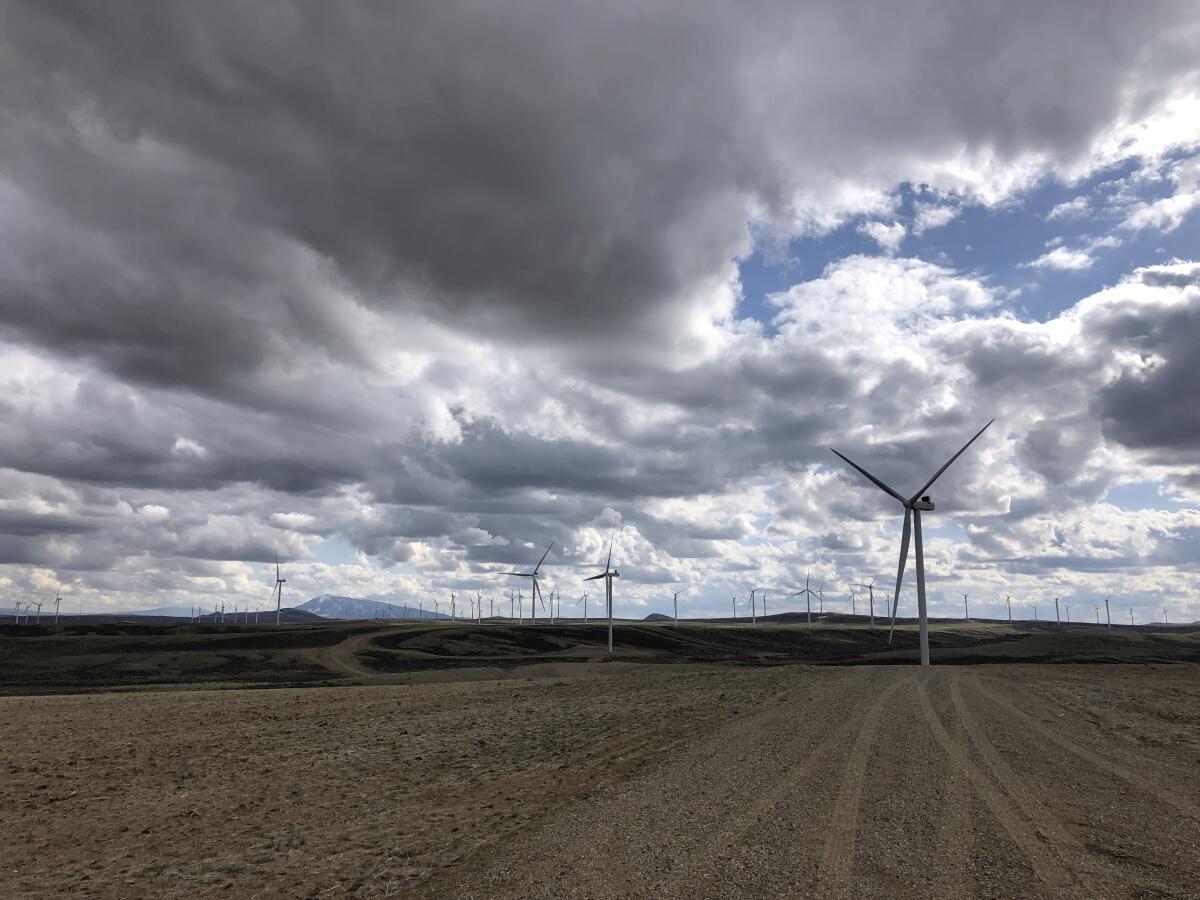
After staying the night in Rawlins, we woke up early the next morning and joined Bill Miller at Overland Trail Ranch — Anschutz’s property, the one that’s bigger than Los Angeles. Miller is a longtime oil and gas “land man” who oversees Anschutz Corp.’s energy and agriculture businesses, and he’s been trying to get this wind farm permitted and built for 15 years. He drove us all over the massive ranch, with a checkerboard land pattern signifying that the American public actually owns half the land.
It’s a gorgeous high-desert landscape, covered by the green-and-brown “sagebrush sea” that serves as habitat for the charismatic bird known as sage grouse — you’ve seen its iconic mating dance, right? — as well as golden eagles, pronghorn and more. It’s also one of the windiest spots in the continental U.S., where powerful gusts are funneled through a low point in the Continental Divide.
The wind machines that Miller intends to prop up at Overland Trail Ranch — early construction activities are underway — would be even bigger than the behemoths we saw at the PacifiCorp site. The largest could have a power capacity of 6.8 megawatts.
As L.A. Times videographers Maggie Beidelman, Jessica Q. Chen and Claire Hannah Collins launched a drone to get aerial footage that I’m sure will be super cool, Miller laughed that he’s crashed his drone when he’s tried to fly it here — the winds are so strong.
“I’ll never retire,” said the 75-year-old Miller, wearing his signature cowboy hat. “This is too much fun — most days.”

I’ll write more in the weeks and months to come about the merits of building a wind farm here — the value of a renewable energy resource that can keep the lights on after sundown, and the tension between fighting the climate crisis and preserving habitat.
For now, I’ll just geek out about the Continental Divide, the dividing line between the watersheds of the Western and Eastern United States. As we stood on Miller Hill — which is not named for the Anschutz executive — we looked west over lands where rainfall drains into the Little Snake River, later flowing into the Yampa River, the Green, the Colorado and eventually the Gulf of California — unless it’s diverted first to grow crops, or to provide drinking water for cities such as Los Angeles or Las Vegas.
Looking east, we saw lands that drain to the North Platte River, whose waters eventually reach the Gulf of Mexico by way of the Platte, the Missouri and the Mississippi. All the way from the eastern slopes of the Rocky Mountains. How cool is that?
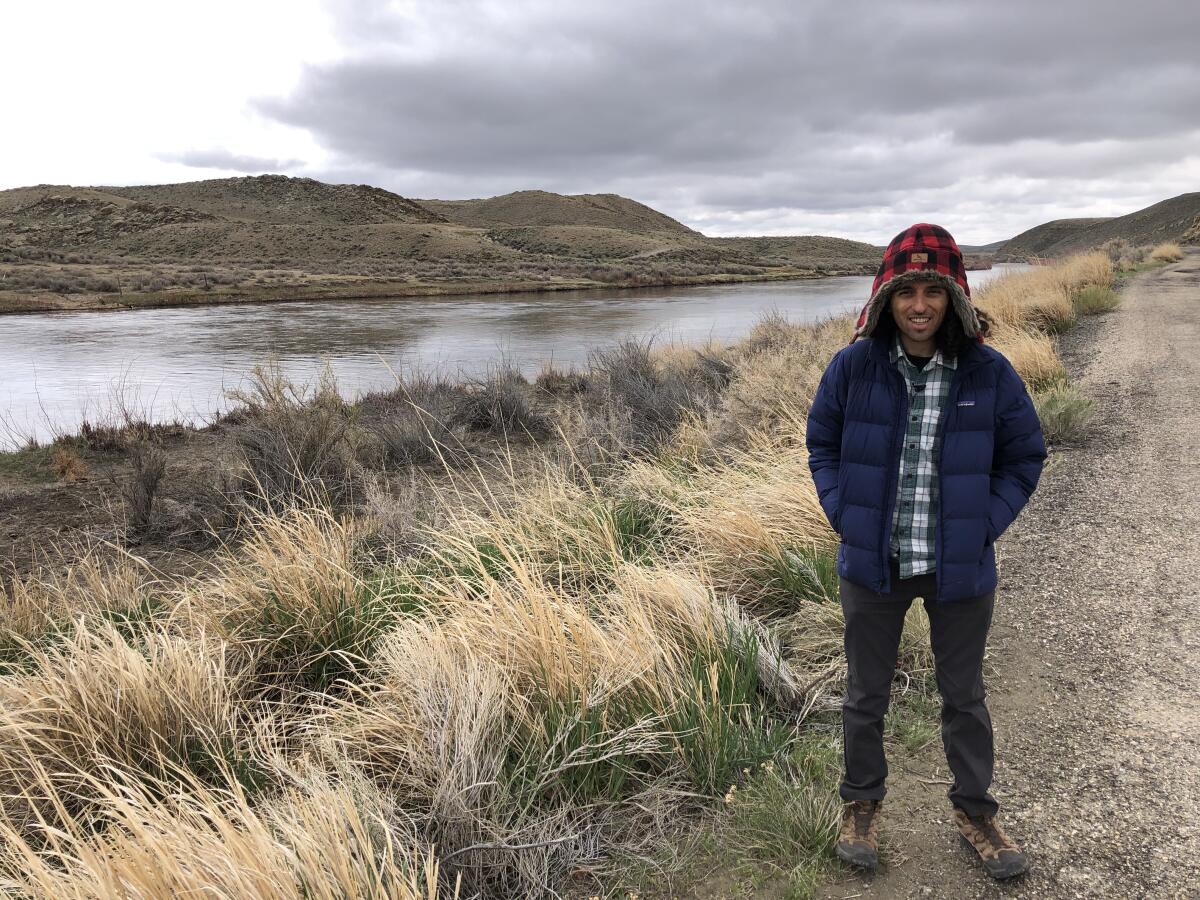
Also cool? All the Western history we’ve seen over the last few days. Such as the Abraham Lincoln Memorial Monument, where a bust of the 16th president sits on a 30-foot granite pedestal overlooking Interstate 80. And the sandstone quarry on the Anschutz ranch whose rock was used to build the Wyoming state Capitol in the 1880s — and to refurbish the building a few years ago.
We’ve picked up some fabulous trivia. One of my favorites is that the Continental Divide Trail — the lesser-known sibling of the Pacific Crest and Appalachian trails — runs through Rawlins alongside the route of the Lincoln Highway, the first transcontinental road for automobiles. Rawlins Mayor Terry Weickum told me he’s seen plenty of Californians walking the trail through town.
“That’s a [tough] hike — the elevation, and just the weather,” he said. “A lot of people don’t realize our elevation is at 6,900 feet.”
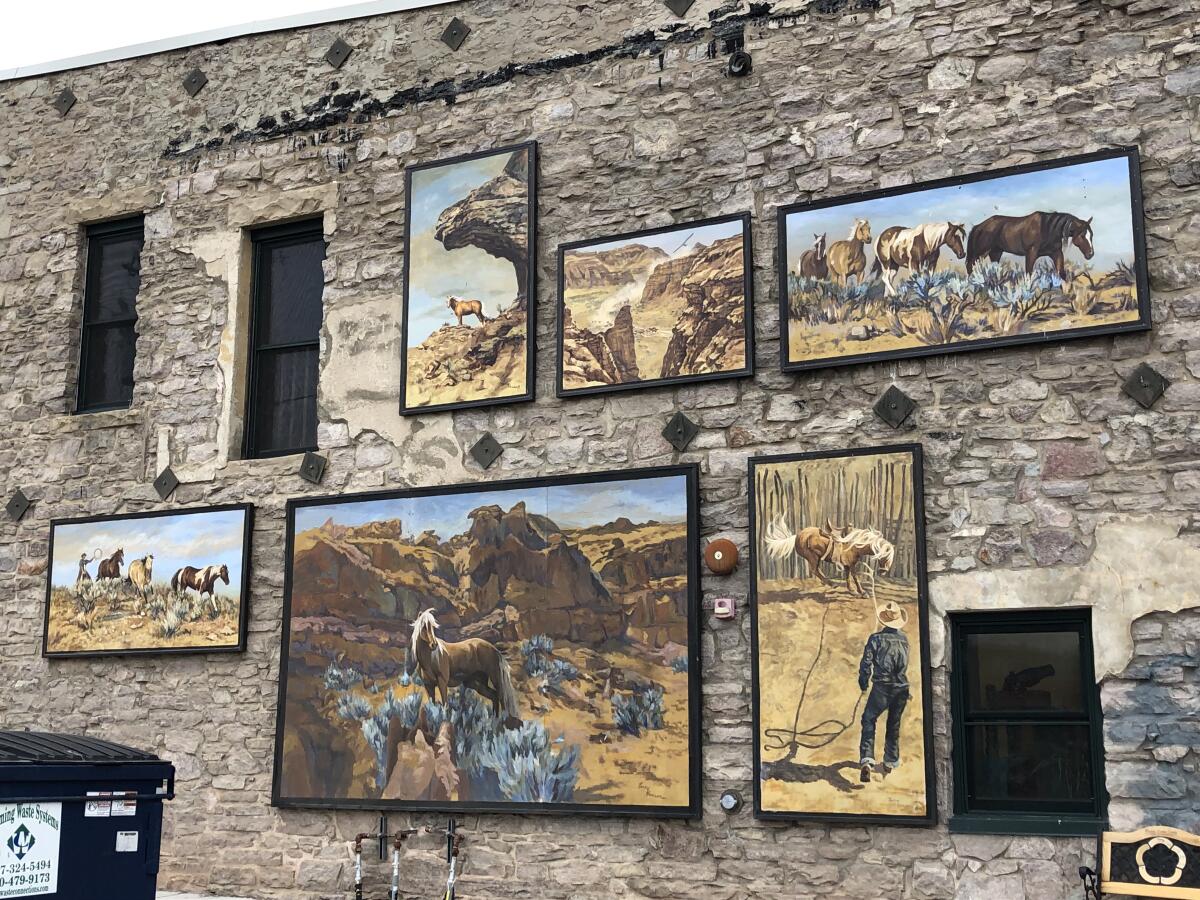
After leaving Rawlins, we drove south toward Colorado, stopping to see historical signage (donated by an oil company) highlighting the history of the Overland Trail, which runs through Anschutz’s ranch and was used as a stagecoach and mail route in the 1860s. The signage featured a not-so-kind review of this part of the country, attributed to Overland Trail traveler Demas Barnes.
“From the Platte west to Fort Bridger...is one almost uninterrupted panorama of barren hills, sandy plains, ugly tortuous ravines, and blank desolation,” the future member of Congress was quoted as saying. “All life and all living things, seem to be gone.”
I understand the sentiment, but personally I find this part of the country stunning. As we crossed into Colorado and hooked west to Utah — following the planned route of Anschutz’s TransWest Express power line as best we could — I was awestruck by the seemingly endless wild lands on either side of the highway, by the snowcapped mountains in the distance, by the way the sun poked in and out of the clouds, by the early-evening light on the Green River, the largest tributary of the Colorado. Even the pollution-spewing smokestacks of the Craig coal plant — scheduled to close by 2030 — couldn’t fully diminish the sweeping vista.
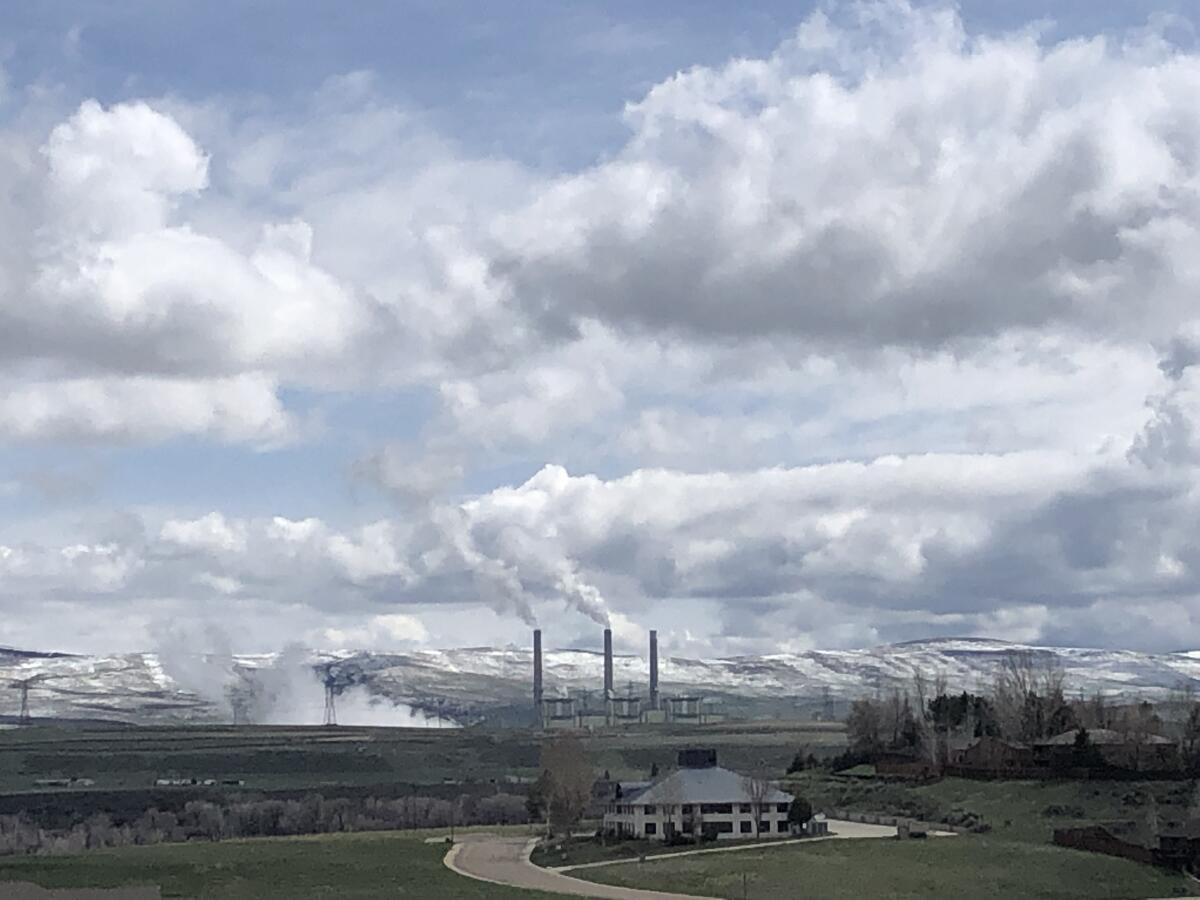
We’ll be on the road a few more days, following the path of the Anschutz power line. Look out for another update next week.
Until then, here’s what’s happening around the West:
TOP STORIES
California Gov. Gavin Newsom told the L.A. Times editorial board he’s reconsidering the long-planned 2025 shutdown of Diablo Canyon, the state’s last nuclear power plant. Newsom is worried California will have trouble keeping the lights on the next few summers without Diablo, and he seems open to the argument that keeping the plant open would be good for fighting climate change, as I reported for The Times. The politically powerful International Brotherhood of Electrical Workers wants to extend Diablo’s life, and California’s main electric grid operator tells me the state needs “additional resources” to limit the risk of blackouts. It’s not just the Golden State at risk of outages; the Arizona Republic’s Ryan Randazzo reports that Arizona, New Mexico and other Western states face similar challenges as temperatures rise, coal plants close and drought saps hydropower supplies.
In an unprecedented move, the Biden administration will hold back nearly half a million acre-feet of water in Lake Powell to keep Glen Canyon Dam from losing the ability to generate hydropower. But critics say federal officials are merely moving water around, rather than taking real steps to reduce demand as climate change diminishes the Colorado River and its tributaries, my colleague Ian James reports. The next few months aren’t looking much better; with La Niña conditions possibly stretching into a third year, the West is staring down another summer of extreme drought and dangerous wildfires, especially if we get a round of intense heat waves, Paul Duginski and Alex Wigglesworth write for The Times. If that’s not grim enough, a barrel washed up in Lake Mead with human remains inside — and Las Vegas police expect to find more bodies as water levels fall, Nathan Solis reports.
California is scrutinizing Exxon Mobil as part of a first-of-its-kind investigation into the fossil fuel industry’s alleged role in causing a global plastic pollution crisis. My colleagues Susanne Rust and Rosanna Xia write that the state’s attorney general, Rob Bonta, has subpoenaed Exxon Mobil, saying fossil fuel and petrochemical companies have “engaged in an aggressive campaign to deceive the public, perpetuating a myth that recycling can solve the plastics crisis.” Exxon denied the accusations. The city of L.A., meanwhile, is tightening restrictions on plastic bags, utensils, food containers and other single-use plastics, as Susanne reports. Bonta’s office is also leading a lawsuit against the U.S. Postal Service, which started paying Oshkosh Defense $482 million to begin production of gas-guzzling mail trucks before conducting an environmental analysis, per the Washington Post’s Jacob Bogage.
WATER AND FIRE

“With this historic drought getting worse, we cannot afford green lawns.” So says Southern California’s water boss Adel Hagekhalil, explaining why homes are being asked to cut back outdoor watering to one day per week; details here from Times reporters Hayley Smith, Ian James and Jaimie Ding. For context, Angelenos use an average of 111 gallons per day; we’re now supposed to get that down to 80 gallons, Hayley and Ian write. Here’s what that means for your trees, and how you can use “grey water” from your laundry or shower to water your garden, as explained by my colleague Jon Healey. But why is the Metropolitan Water District requiring these cutbacks only for cities dependent on Northern California river water, and not cities dependent on water from the Colorado River — which, as I mentioned above, is also in big trouble? Ian and Hayley scrutinized that decision.
Gov. Gavin Newsom called for the California Coastal Commission to approve a seawater desalination facility in Huntington Beach. In an interview with the Bay Area News Group editorial board, the governor suggested rejecting the desal plant would be “dumb,” saying “we need more tools in the damn tool kit” to cope with drought, as Paul Rogers writes for the Mercury News. L.A. Times columnist Michael Hiltzik made the opposite case, writing that the proposed facility would “do almost nothing to resolve water supply issues” and would “suck up financial resources better directed toward other social issues.” Times columnist George Skelton made a similar argument about proposals in Sacramento to send cash rebates to Californians to offset high gasoline prices, writing that the money would be better spent on infrastructure such as renewable energy projects and electric vehicle chargers.
President Biden issued a disaster declaration as wildfires raged across New Mexico. The blazes have displaced thousands of people and destroyed 172 homes, Cedar Attanasio and Susan Montoya Bryan write for the Associated Press. And in the background of these climate-stoked conflagrations? New Mexico is the nation’s second-largest oil and gas producer, and fossil fuel firms and executives are some of the largest campaign contributors in this year’s elections, the Albuquerque Journal’s Dan McKay reports. Also in the Land of Enchantment, oil and gas interests “have deployed a months-long campaign to depict schools and children’s wellbeing as under threat if government officials infringe upon fossil fuel production,” Leanna First-Arai writes for the Guardian.
AROUND THE WEST
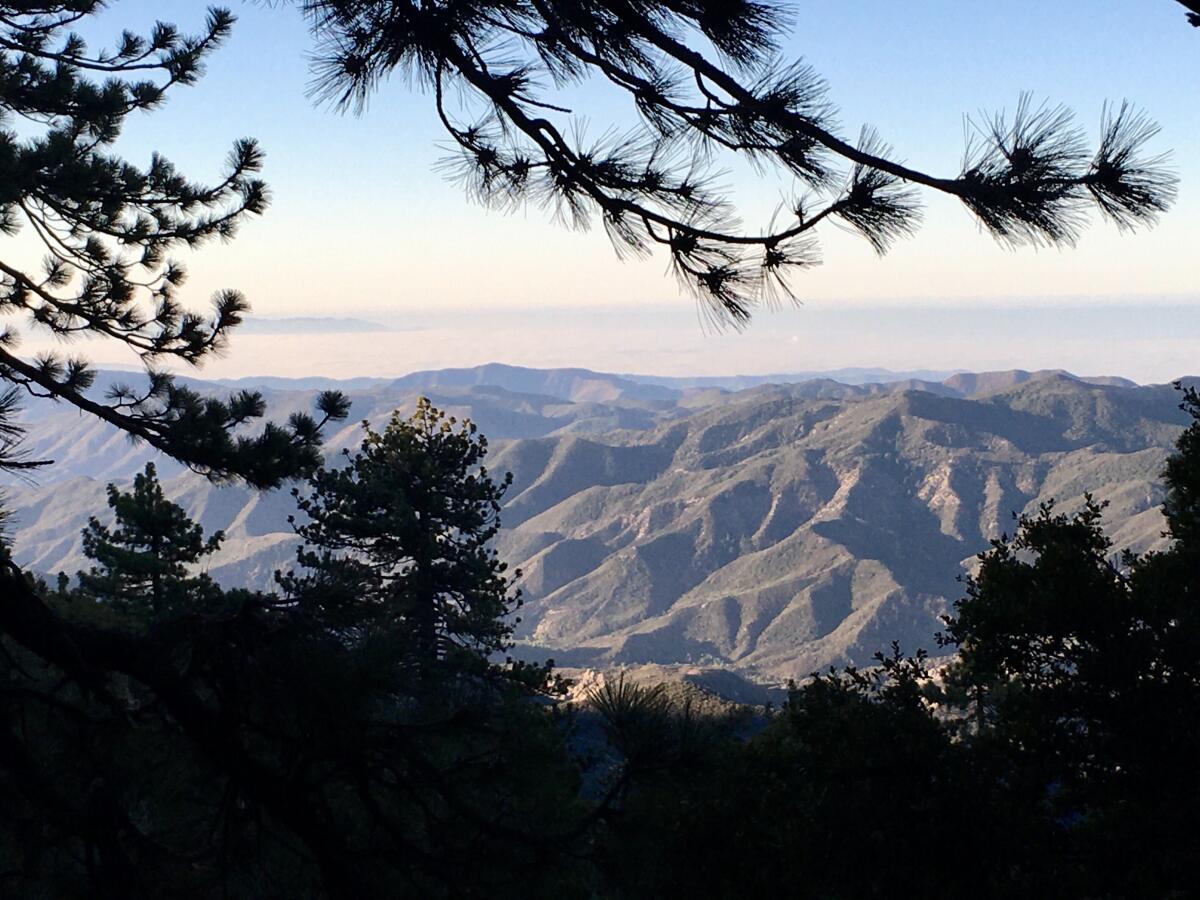
The Ventura-based outdoor retailer Patagonia joined a lawsuit against a forest-thinning project in Los Padres National Forest, which critics see as logging in disguise. Most wildfire experts see forest thinning as a crucial tool for keeping blazes from getting out of control, but critics argue these projects mostly benefit logging companies and don’t actually improve forest health, as The Times’ Christian Martinez writes in a story about the Los Padres lawsuit. Whoever is right, something needs to be done to deal with worsening wildfires in the West. Paul Thornton wrote about fire reshaping beloved mountain hikes, lamenting that the flames “are turning shaded trails into ashen hellscapes” in Southern California’s San Bernardino and San Gabriel mountains.
As the endangered Devil’s Hole pupfish population continues to recover in its remote Death Valley habitat, researchers are increasingly excited about opportunities to study the rare fish. Here’s the hopeful story from my colleague Louis Sahagún, who writes that the secret to the pupfish’s survival “remains a biological mystery.” Farther north, the Sacramento Bee’s Ryan Sabalow writes that critically endangered salmon “are again swimming above a century-old dam” in the shadow of the Mount Lassen volcano — but don’t call it a habitat-restoration success story, at least not yet. Elsewhere in Northern California, condors returned to a slice of redwood habitat for the first time in 130 years, soaring over Yurok tribal lands, Nathan Solis writes for The Times.
The Biden administration is offering $3.1 billion to support the domestic supply chain for electric vehicle batteries. Details here from Arianna Skibell at E&E News. But at the same time, the administration is supporting an oil train through Utah’s Wasatch Mountain that would help grow fossil fuel production in the Uinta Basin, and seemingly claiming the train would help fight climate change, as Stephanie Mencimer reports in an eye-opening investigation for Mother Jones. In other battery supply chain news, California created the Lithium Valley Commission to make sure Salton Sea communities benefit from the coming lithium boom — but the commission has no budget, no paid staff and abruptly canceled its last meeting, Janet Wilson reports for the Desert Sun.
THE ENERGY TRANSITION
There was a lot of talk on Twitter about California hitting 100% clean energy for the first time this past weekend, when moderate temperatures and sunny skies created the perfect storm for not needing fossil fuels. I checked with the California Independent System Operator, and they told me there was enough renewable energy on the grid Saturday — briefly — to meet 99.87% of demand on the state’s main power grid. That’s a big deal! There are also lots of caveats, such as the fact that gas plants were still running, as clean energy researcher and advocate Mike O’Boyle explains for Canary Media. In the meantime, another state leapfrogged California on climate, with Connecticut lawmakers voting to mandate 100% clean energy by 2040 — five years ahead of the Golden State. And as California prepares its long-term climate strategy, critics say state officials are poised to allow far too much fossil fuel combustion at the expense of low-income communities and people of color, per Nadia Lopez at CalMatters.
The nation’s largest solar farm — the 690-megawatt Gemini project on public lands in Southern Nevada — has secured financing and will soon start construction. The project is moving forward despite opposition from some environmentalists, as Eric Wesoff writes for Canary Media. Elsewhere on public lands, the Bureau of Land Management approved exploratory drilling for geothermal energy in western Utah, and is nearing approval of the SunZia transmission line, which would help carry New Mexico wind power to California (stories by Brian Maffly at the Salt Lake Tribune and Susan Montoya Bryan at the Associated Press). Also good for renewable energy? Bonneville Power Administration and Tucson Electric Power officially joined the Western Energy Imbalance Market, Kassia Micek reports for S&P Global. For context, see my story from last year on the power-sharing program.
The Environmental Protection Agency won’t force the shutdown of two units at Wyoming’s Jim Bridger coal plant, as long as PacifiCorp cuts down on their use before converting them to natural gas. Climate activists were disappointed; here’s the story from WyoFile’s Dustin Bleizeffer. PacifiCorp is part of Warren Buffett’s Berkshire Hathaway empire, whose shareholders just rejected a climate resolution urging the company to disclose more about its emissions.
ONE MORE THING
A few nights before leaving for my Western road trip, I watched “The Two Jakes,” the lesser-known 1990 sequel to the Jack Nicholson classic “Chinatown.” It wasn’t quite as good as the original. But I loved that where the plot of “Chinatown” was inspired by L.A.’s infamous Owens Valley water grab, “The Two Jakes” dealt with another key aspect of Los Angeles history: oil drilling.
I won’t spoil the film. But I will leave you with a quote.
“The city’s different at night,” Nicholson’s character, private detective J.J. Gittes, says in a voiceover. “The air smells better. It’s harder to see that the oil rigs outnumber the palm trees, and it’s almost like the good old days.”
We’ll be back in your inbox next week. If you enjoyed this newsletter, please consider forwarding it to your friends and colleagues.




